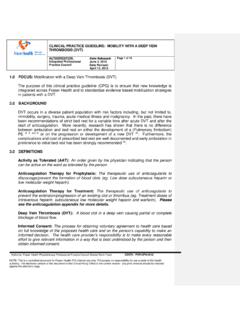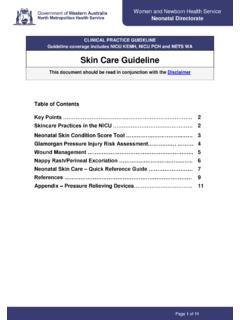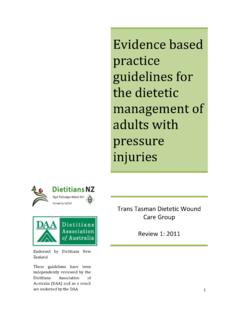Transcription of Occupational Therapy Skin Care Guideline
1 Occupational Therapy Skin care Guideline Best Practice for the Prevention and Treatment of Pressure Ulcers Created by the Occupational Therapists in Vancouver Coastal Health and Providence Health care April 2008. Occupational Therapy SKIN care Guideline FOR VCH/PHC. BEST PRACTICE FOR THE PREVENTION AND TREATMENT OF PRESSURE ULCERS. ACKNOWLEDGEMENTS. This Guideline has benefited from the contributions of many Occupational therapists. We would like to acknowledge the following contributors: Occupational therapists in Vancouver Coastal Health and Providence Health care who participated in the Huddles and trialled the guidelines . Members of the Core Committee: Elaine Au Jeanette Boily Linda Boronowski Jo Clark Dawn Daechsel Guylaine Desharnais Sandy Leznoff Jenny Finnegan Members of the Equipment Group: Jeanette Boily Guylaine Desharnais Peter Haughton George Kokuryo Cheryl Sheffield Joanne Yip Members of the Documentation Group: Elaine Au Samantha Carter Jenny Finnegan Teresa Green Sandy Leznoff April 2008 2 of 53.
2 Occupational Therapy SKIN care Guideline FOR VCH/PHC. BEST PRACTICE FOR THE PREVENTION AND TREATMENT OF PRESSURE ULCERS. TABLE OF CONTENTS. Acknowledgements .. 2. Table of Contents .. 3. Purpose and Scope .. 4. Levels of Evidence .. 4. Schematic of Best Practice for the Prevention and Treatment of Pressure Ulcers .. 6. Best Practice Recommendations for Occupational 8. Professional Practice .. 8. VCH/PHC Recommended 8. Recommended External 9. Risk Assessment .. 9. Braden Scale .. 9. Risk Factors .. 10. Skin Assessment .. 10. Record Assessment .. 11. Develop a care Plan .. 11. Occupational Therapy Intervention .. 11. Positioning Schedule .. 11. Repositioning 12. Support 13. Pain .. 18. 18. Nutrition .. 19. Communication .. 19.
3 Education .. 19. Reassessment .. 20. Appendix 1 Glossary of Terms .. 21. Appendix 1A Pressure Ulcer Definition and Stages .. 22. Appendix 1B Interdisciplinary Decision Grid for Topical Treatment of Wounds (Excluding Burns and Malignant Wounds).. 23. Appendix 1C Physical Concepts Related to Support Surfaces .. 24. Appendix 1D Categories of Support 25. Appendix 1E Features of Support Surfaces .. 26. Appendix 2 Grading Levels of Evidence .. 27. Appendix 3 Braden Pressure Ulcer Risk Assessment .. 28. Appendix 4 Skin care Risk Assessment Form guidelines and Template .. 30. Appendix 4A Occupational Therapy Skin care Risk Assessment Form Template .. 33. Appendix 5 care Planning Considerations .. 35. Appendix 6 Mattress and Overlay Support Surfaces Decision Tree for Persons at Risk or With Existing Wound(s).
4 38. Appendix 7 Heel Protection Decision Tree .. 39. Appendix 8A Seating Decision Tree (Low Risk) .. 40. Appendix 8B Seating Decision Tree (Moderate Risk).. 41. Appendix 8C Seating Decision Tree (High Risk) .. 42. Appendix 9 Practice Guideline References .. 43. Appendix 10 Search Strategies .. 44. Appendix 11 Bibliography .. 45. April 2008 3 of 53. Occupational Therapy SKIN care Guideline FOR VCH/PHC. BEST PRACTICE FOR THE PREVENTION AND TREATMENT OF PRESSURE ULCERS. PURPOSE AND SCOPE. The development of a pressure ulcer significantly impacts the individual's ability to participate in activities of daily living (ADL). The Occupational therapist's expertise can be used to identify causative factor(s) to skin breakdown, and to make recommendation(s) that protect the skin or promote wound healing while promoting participation in meaningful occupation.
5 The Occupational Therapy Skin care Guideline was developed over several years (2005-2007) with the intention of: Supporting Occupational Therapy practice through the continuum of care including acute;. rehabilitation, residential and community services;. Providing evidence-based recommendations to direct Occupational Therapy practice;. Providing tools and resources to facilitate clinical reasoning;. Integrating recommendations into broader inter-professional practice. An inter-professional team provides best practice for the prevention and treatment of pressure ulcers. As such, some aspects of the Occupational Therapy Skin care Guideline may be completed by other disciplines depending on the individual practice environment.
6 The interventions discussed focus on the Occupational Therapy contribution. The Guideline includes a schematic summarizing the flow of care followed by evidenced-based recommendations applied to Occupational Therapy practice across the continuum of care . Furthermore, explanations of terms and concepts used throughout the Occupational Therapy Skin care Guideline are included in Appendix 1 Glossary of Terms. In order to bring equal emphasis to the prevention of skin breakdown, it was elected to refer to a skin care Guideline rather than a wound care Guideline . Please note: the Occupational Therapy Skin care Guideline is not intended for venous leg ulcers, burns or arterial wounds. LEVELS OF EVIDENCE. The Occupational Therapy Skin care Guideline has been developed using: Existing nursing guidelines (see Appendix 9 Practice Guideline References).
7 Research evidence (see Appendix 10 Search Strategies and Appendix 11 Bibliography);. Consensus from Occupational therapists within Vancouver Coastal Health (VCH) and Providence Health care (PHC) with expertise in pressure ulcer prevention and treatment where gaps in the current research evidence exist. The table on the next page reflects the strength of evidence for specific recommendations within the Registered Nurses Association of Ontario (RNAO) guidelines . These are used to provide a summary of available evidence. In order to improve the readability and flow of this document, levels of evidence for individual recommendations in the Occupational Therapy Skin care Guideline are not listed. Additional information is included in Appendix 2 Grading Levels of Evidence.
8 April 2008 4 of 53. Occupational Therapy SKIN care Guideline FOR VCH/PHC. BEST PRACTICE FOR THE PREVENTION AND TREATMENT OF PRESSURE ULCERS. TABLE 1: LEVELS OF EVIDENCE FOR INTERDISCIPLINARY PRACTICE RECOMMENDATIONS. Source: Keast, DH et al. (2006). Best Practice Recommendations for the prevention and treatment of pressure ulcers: Update 2006. Wound care Canada, 4 (1), pp 31-43. Copied and used with permission publisher. Registered Nurses Association of Ontario (RNAO). (2005). Risk assessment and prevention of pressure ulcers. Toronto ON. April 2008 5 of 53. Occupational Therapy SKIN care Guideline FOR VCH/PHC. BEST PRACTICE FOR THE PREVENTION AND TREATMENT OF PRESSURE ULCERS. SCHEMATIC OF BEST PRACTICE FOR THE PREVENTION AND.
9 TREATMENT OF PRESSURE ULCERS. The Schematic of Best Practice for the Prevention and Treatment of Pressure Ulcers included on the next page is designed to provide an overview of the process for assessment and intervention for Occupational therapists. It emphasizes inter-professional responsibilities for risk assessment and skin assessment, and focuses on Occupational Therapy 's contributions to the inter-professional care plan. The headings in the schematic are used throughout the Occupational Therapy Skin care Guideline to provide more in-depth information. April 2008 6 of 53. Occupational Therapy SKIN care Guideline FOR VCH/PHC. BEST PRACTICE FOR THE PREVENTION AND TREATMENT OF PRESSURE ULCERS. DIAGRAM 1: SCHEMATIC OF BEST PRACTICE FOR THE PREVENTION AND TREATMENT OF PRESSURE ULCERS.
10 Holistic assessment, management and intervention are the responsibility of the inter-professional team Perform or access information from the initial risk assessment in the person's first episode of care Occupational Therapy Intervention Any intervention must take into consideration the identified risk(s) and Risk assessment causative factor(s) of the skin breakdown. The following are possible options Risk factors include: to consider and should not be viewed as an exhaustive list. Referrals should Environment be made to interdisciplinary team members as appropriate. Person Pressure Previous skin Decreased mobility Shearing Professional Practice Positioning Schedule breakdown Skeletal deformity, Friction Ensure knowledge of up-to-date Consider all support surfaces throughout a Sensory impairment muscular atrophy and Moisture equipment, consider strength of evidence 24-hour period.







